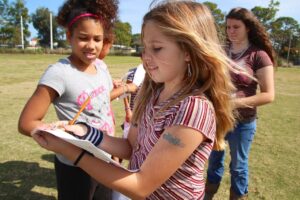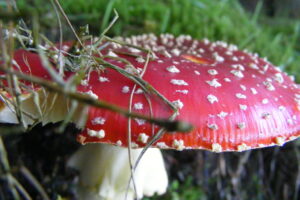
GUEST BLOGGER INEZ YUWANITA
Science is… everywhere. It starts simple, with simple questions: How do we see with our eyes? What makes broccoli taste yucky and hot dog taste good? Why do we like sweets? From those questions then comes the learning: where can we get the information? What books should we read? And, the million-dollar question: Can we see it in real time?
I think I should backtrack for a bit and introduce myself. I am a scientist. It feels awkward for me to call myself one – most of the time I think of myself as this endlessly curious child in the world of infinite potential findings. My initial burning question that started my foray in the world of science was: why am I a girl and not a boy, why is my cousin a boy and not a girl? The answer to which I learned in high school, about 10 years after I posed that initial question: X and Y chromosomes. Then I learned about patterns of inheritance, about Mendel and his peas (he should get Nobel Price of Peas… get it?), and the rest is history.
Science to me is an endless adventure. However, to begin an adventure, one should be interested in the adventure itself. How to best engage that sense of adventure than by telling a story? I recently gave my students a lecture on scientific communications. Much like telling a fictional story, scientific communications require a background, an introduction to characters, a problem and a solution, and a conclusion. Only the great part about a scientific story is that the conclusion is never the end of the story.
Use crickets to practice communicating scientifically
In the classroom, for instance, students can start by observing their surroundings, tenet #1 in the scientific process. For instance, listen to the sound of a cricket.
- Today’s weather may be fair, but tomorrow it may rain. Does that change the chirp?
- Are there fewer chirps or more chirps depending on the weather?
- What will happen if we extend it for another day? Another week? Another month?
- Is there a clear correlation between the sound crickets make and the weather?
Students can then make hypotheses. If the chirps of the animals are different due to the weather, what exactly are they responding to? Weather change means a change in humidity level and temperature. Both of which can be tested in the scope of the classroom. Scientific American posted a simple experiment involving only a thermometer and a stopwatch to examine whether cricket chirps are affected by temperature.
Compared these results to indoor crickets. Is there any difference? If we change the temperature of the room, what will that do to those crickets?
If there’s a difference between the crickets outside and inside, we can then conclude that there’s a correlation between temperature and the amount of cricket chirps. But if there isn’t, the subsequent experiment with changing the temperature of the room would help confirm whether there is a correlation between temperature and cricket chirps. If the cricket inside behave quite unlike the hypothesis, then something else may explain the increase/decrease in chirps. Is it mating season, perhaps, or just aggression?
The crickets’ story – the connection to language arts
If students were to write a report on this experiment, how would it be written? By telling a story, of course. The background and setting of the story would be the initial observations including the weather pattern; the characters would be the crickets themselves; the problems would be the variables being tested: cricket chirps and temperature; and the conclusion would be the findings. But, remember, science is a never-ending story. So, what can the students do to explore further? Maybe a new variable? Maybe an examination into a combination of both temperature and humidity?
In the crux of it all is communication. Science thrives to this day because it is continuously being propagated through ALL methods of communications. The notion that there’s a division between the language arts and science is quite absurd. We are living beings, we do not exist in vacuum. The ability to communicate is vital to survival.
Language and science are both sides of the same coin. In science, one must be able to present their findings as proof of their research activities and to secure more support for their research. Clearly, the ability to utilize language effectively is very important for these types of communications to work successfully.

Inez Yuwanita is a scientist based on her academic degree. However, she most closely resemble someone with a Peter Pan syndrome fueled and enabled by science. She earned her PhD in Microbiology and Molecular Genetics because she wanted a license to play in the science world without any restrictions. When she’s not doing anything related to science, she’s drawing (usually about science). She enjoys science immensely because it allows her to see the world as a place with infinite possibilities and discovery.
Featured photo credit: NCPedia via Creative Commons








Leave a Reply
Your email is safe with me.